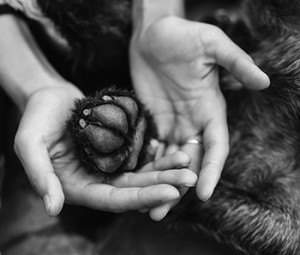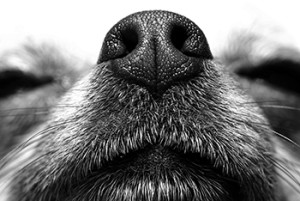 Written by Kelly Roberson
Written by Kelly Roberson
When Ira and Lisa Lacher’s soft-coated Wheaten terrier, Corky, turned 13, he started to have trouble with his joints. “He’d be asleep and would struggle to get to his feet, or have trouble navigating our stairs, and he developed a noticeable limp,” Ira says.
Help, it turned out, came from what’s becoming an increasingly common—and seemingly effective—therapy for pets of all sorts: holistic veterinary medicine. The Lachers, who live in Des Moines, sought out a mix of traditional medications and herbal therapy, as well as acupuncture, at the Iowa Veterinary Wellness Center. After a treatment, “over the next day or so, he shows dramatic improvement, enough to make us believe it’s worth it,” Ira says. “Even at the human equivalent of being 90-plus, he does become more sprightly, and has the get-up-and-go of a younger dog.”
One thing’s for certain about our pets: Americans love them ferociously, to the tune of $59 billion in 2014, one-quarter of that spent on pet health, according to the American Pet Products Association. And more and more veterinarians are offering integrative or holistic therapies.
Some vets combine traditional and holistic approaches, while others focus solely on alternative modalities. Veterinarian Deidre Farr, owner of Natural Solutions in Des Moines, is an example of the latter. She sold her traditional veterinary practice after 14 years, only to establish an office several years later devoted solely to acupuncture, chiropractic care and herbal remedies. Traditional Western medicine “is lifesaving, but (it) does not treat chronic disease very well,” Farr says. A holistic approach “is extremely effective at filling that gap, and one more tool we can use to help keep pets healthy and treat disease.”
That holistic toolbox for pets is big and varied. Examples include homeopathy, acupuncture (both laser and traditional needles), chiropractic care, herbal products, ayurveda, physical therapy, osteopathic manipulation, essential oils and ozone therapy (see story, opposite page). The biggest hurdle for many practitioners is lack of awareness. “I think people find holistic treatment for themselves before they find it for their pets,” Mona Boudreaux, president of the American Holistic Veterinary Medical Association, said in a phone interview from Maryland. “And they might not believe it works—they go to a trained Western practitioner and that’s all they know. Holistic veterinary care doesn’t have to wait until a diagnosis of a disease. These modalities shine in helping to prevent disease and keep pets healthy.”
 Kim Wilke, a veterinarian with the Iowa Veterinary Wellness Center in Des Moines, discovered holistic pet care before she became a vet. “In the late 1990s, I was working on my undergraduate (program) to become a vet, and my dog had arthritis,” she says. “I was introduced to acupuncture and I saw what a benefit it gave my dog, and I wanted to be able to help patients that way.”
Kim Wilke, a veterinarian with the Iowa Veterinary Wellness Center in Des Moines, discovered holistic pet care before she became a vet. “In the late 1990s, I was working on my undergraduate (program) to become a vet, and my dog had arthritis,” she says. “I was introduced to acupuncture and I saw what a benefit it gave my dog, and I wanted to be able to help patients that way.”
However, Wilke first learned traditional medicine, then mentored with a holistic practitioner. “The way I describe it, it’s the best of both worlds. If you have a sick pet, we use the thing that’s the most effective and has the least (number of) side effects,” she says.
Both Wilke and Farr treat a variety of pets, conditions and illnesses: cats in pain, dogs with behavior problems, animals with gastrointestinal or aggression issues. There are the unusual cases too: Farr’s first patient was a parakeet that couldn’t perch; she got it to start flying again with acupuncture. And Wilke gave acupuncture to a pet rooster that had arthritis in its hips.
Holistic vets have different approaches to their practice, but Farr and Wilke agree that diet may be the root cause of a lot of problems with today’s pets. “I tend to be very fortunate (because) someone who brings a pet to me is a very involved owner and trying to do the best they can,” Farr says. “But I think the number-one problem across the board is diet. The food is highly processed, and it has a high carb content. We’re feeding carnivores way too many carbs, and that leads to obesity, allergies and an inability to fight disease.”
Sherri Harding, a West Des Moines dog groomer who owns Small Dog Bed and Breakfast, has been feeding her dogs a raw food diet for the past 20 years. Until recently, she made the food herself out of raw meat (beef, pork, chicken or organ meats), calcium citrate or bone meal, and vegetables, including kale, spinach, carrots, berries or squash, depending on the season. “The beautiful thing about the raw food diet is that my dogs never get sick,” says Harding, who, with her husband, Pat, currently has six Havenese dogs, the oldest of which is still healthy at age 14. “They’ve had no skin, tummy or other health problems.”
Because of the time commitment involved in making the food, though, Harding recently started using a commercial raw food company, Utah-based Steve’s Real Food for Pets. She’s also a fan of other forms of holistic care, including the use of essential oils. One of her favorite mixtures consists of 32 ounces of water, one drop of dish soap, 32 drops of tea tree oil and 10 drops of lemon oil. She keeps the spray on hand as a disinfectant for her counters and as a room deodorizer, as well as to treat fleas.
“I’ve come to realize that no matter what the problem may be, you can almost always use a holistic, instead of a pharmaceutical, approach and avoid harsh side effects,” she says, adding that, because her dogs are so healthy, her costs for veterinary care are almost nonexistent. “There’s a whole beautiful holistic world out there that’s much better than any pharmaceutical one.”
That holistic world is one in which both Wilke and Farr say they still have their “aha” moments. “I’ve been able to help paralyzed dogs walk, and I’ll think, ‘It does work,’ ” Wilke says. “I see miracles every day, and I’m still amazed.”
 Alternative Treatments
Alternative Treatments
Sure, homeopathy and ozone therapy may sound interesting, but what are they, exactly, and how could your pet benefit from them? A sampling of holistic therapeutic techniques:
Aromatherapy: Essential oils extracted from herbs and flowers have an aroma that can boost healing. Lavender may help reduce anxiety, for example, while other oils are used to soothe muscular aches. However, because the quality and potency of oils vary widely, vets say they should be used with caution, especially on dogs because of their heightened sense of smell.
Ozone Therapy: This treatment uses medical-grade ozone, a highly reactive form of pure oxygen, to stimulate the body to regenerate and cure itself. Inflammation increases the amount of carbon dioxide in the body; the ozone helps remove this and other impediments.
Some holistic vets have been using this therapy for about 20 years to treat a variety of conditions, such as viral and bacterial infections, liver disease, kidney malfunction and damaged joints.
Veterinary Chiropractic: This therapy is based on manual spinal manipulation, with the goal to restore the critical relationship between the spine and the central nervous system, thereby stimulating the body’s ability to heal itself. Chiropractic is used to treat joint pain and degeneration, hip dysplasia, incontinence, muscle spasms, injuries from accidents and falls, and tail injuries, among other conditions.
Homeopathy: Developed by a German physician in the 1800s, this medical system works on the principle that a minute dose of a substance that is “like” the disease will stimulate the patient’s immune system and cure the disease. Conditions that have responded to homeopathy include asthma, epilepsy, diabetes and skin allergies.
Acupuncture: In existence for more than 4,000 years, acupuncture involves stimulating “acupoints,” which are located along the surface of the body, with very thin, solid needles. The stimulation activates “chi,” which traditional Chinese medicine defines as the vital force that flows throughout the body along energy channels called meridians. Veterinarians use acupuncture to strengthen pets’ immune systems, relieve pain and improve internal organ function.
Herbal Medicine: Around the world and in nearly every culture, medicinal herbs and plants have been used both for disease prevention and for treatment, from ancient times to today. The range of conditions plants and herbs treat is extensive. Examples: ginger for stomach upset, goldenseal for eye infections, milk thistle for liver disease and chamomile for anxiety.
Sources: American Holistic Veterinary Medical Association; New York Complementary & Alternative Veterinary Medical Association; Academy of Veterinary Homeopathy; American Academy of Ozonotherapy.




Show Comments (1)
Ann Robinson, Des Moines
Appreciated this feature on a topic with which I was somewhat familiar but had not explored. It was educational and answered many of my questions on pet wellness and preventive therapies, and local opportunities.
Comments are closed.